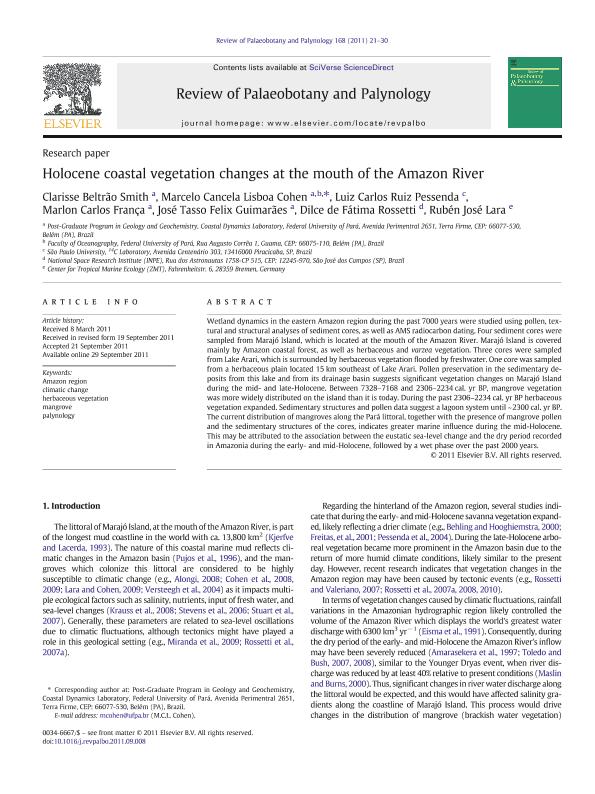Artículo
Holocene coastal vegetation changes at the mouth of the Amazon River
Smith, Clarisse Beltrão; Cohen, Marcelo Cancela Lisboa; Pessenda, Luiz Carlos Ruiz; França, Marlon Carlos; Guimarães, José Tasso Felix; Rossetti, Dilce de Fátima; Lara, Ruben Jose

Fecha de publicación:
08/2011
Editorial:
Elsevier Science
Revista:
Review of Palaeobotany and Palynology
ISSN:
0034-6667
Idioma:
Inglés
Tipo de recurso:
Artículo publicado
Clasificación temática:
Resumen
Wetland dynamics in the eastern Amazon region during the past 7000 years were studied using pollen, textural and structural analyses of sediment cores, as well as AMS radiocarbon dating. Four sediment cores were sampled from Marajó Island, which is located at the mouth of the Amazon River. Marajó Island is covered mainly by Amazon coastal forest, as well as herbaceous and varzea vegetation. Three cores were sampled from Lake Arari, which is surrounded by herbaceous vegetation flooded by freshwater. One core was sampled from a herbaceous plain located 15 km southeast of Lake Arari. Pollen preservation in the sedimentary deposits from this lake and from its drainage basin suggests significant vegetation changes on Marajó Island during the mid- and late-Holocene. Between 7328–7168 and 2306–2234 cal. yr BP, mangrove vegetation was more widely distributed on the island than it is today. During the past 2306–2234 cal. yr BP herbaceous vegetation expanded. Sedimentary structures and pollen data suggest a lagoon system until ~ 2300 cal. yr BP. The current distribution of mangroves along the Pará littoral, together with the presence of mangrove pollen and the sedimentary structures of the cores, indicates greater marine influence during the mid-Holocene. This may be attributed to the association between the eustatic sea-level change and the dry period recorded in Amazonia during the early- and mid-Holocene, followed by a wet phase over the past 2000 years.
Palabras clave:
Amazon
,
Climate
,
Vegetation
,
Palynology
Archivos asociados
Licencia
Identificadores
Colecciones
Articulos(IADO)
Articulos de INST.ARG.DE OCEANOGRAFIA (I)
Articulos de INST.ARG.DE OCEANOGRAFIA (I)
Citación
Smith, Clarisse Beltrão; Cohen, Marcelo Cancela Lisboa; Pessenda, Luiz Carlos Ruiz; França, Marlon Carlos; Guimarães, José Tasso Felix; et al.; Holocene coastal vegetation changes at the mouth of the Amazon River; Elsevier Science; Review of Palaeobotany and Palynology; 168; 8-2011; 21-30
Compartir
Altmétricas



